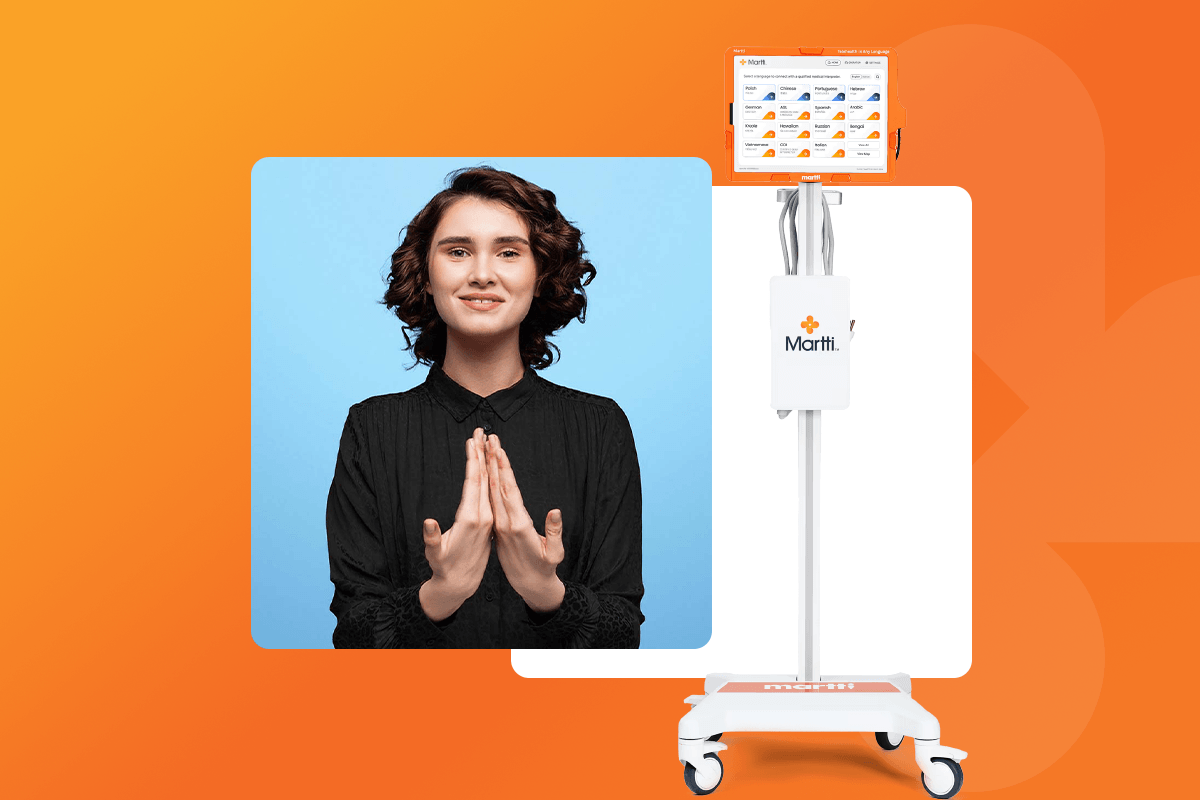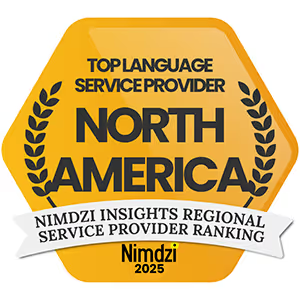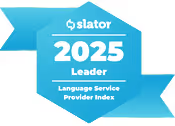Communication errors can have serious consequences in a medical setting. Patients need to understand their diagnoses, treatment options, and medications. Providers need accurate information about symptoms, history, and concerns. When language is a barrier, misunderstandings can lead to misdiagnoses, incorrect treatments, and lower patient satisfaction.
What is Video Remote Interpreting (VRI), and how can it improve service quality in your healthcare facility? As healthcare becomes more diverse, understanding VRI is essential for improving patient outcomes, ensuring compliance with legal requirements, and enhancing overall efficiency. Find out what VRI means to medical teams, how you can integrate it into daily operations, and what a reputable VRI partner can offer your organization.
What Is VRI?
Clear communication is the foundation of quality healthcare. For patients with limited English proficiency (LEP) or those who are Deaf or hard of hearing, language barriers can make medical care stressful, confusing, and even dangerous. VRI offers a fast, reliable solution that connects patients and providers with qualified interpreters at the touch of a button.
Federal laws, such as the Americans With Disabilities Act (ADA), require healthcare providers to offer language access services. While on-site interpreters play an important role, VRI offers distinct advantages in many situations.
Applications and Use Cases of VRI
VRI is transforming healthcare by bridging language barriers. It is a strategic tool for hospitals, clinics, and telemedicine providers that ensures compliance with language access regulations while optimizing efficiency. It is useful across many healthcare departments, including admissions and discharge, where healthcare professionals practice medicine and patients receive critical information about procedures, medications, and follow-up care.
Emergency Situations
Every second counts in emergencies, and clear communication is critical for accurate diagnosis and treatment. VRI enables real-time interpretation services for patients and allows physicians to obtain accurate medical histories, assess symptoms, and explain procedures.
Routine Appointments
VRI is increasingly used in primary care, outpatient clinics, and telehealth appointments, which are becoming more common and require accessible communication options. Its features improve accessibility for diverse patient populations, enhancing patient satisfaction and appointment efficiency.
Specialized Services
During specialist visits, accurate interpretation ensures that the healthcare team can obtain the information needed for diagnoses and treatment plans and allows patients to communicate about their care. These include, for example, mental health counseling, oncology, chronic disease management, and surgical consultations, helping patients fully understand pre- and postoperative instructions.
Benefits of VRI in Healthcare
VRI helps healthcare providers overcome communication barriers and encourages those with hearing impairment to seek help they may otherwise avoid due to a lack of communication means and readily available interpreters. Investing in VRI products benefits both patients and healthcare providers in other ways:
- Immediate access to interpreters: Medical emergencies don't wait. When a patient arrives in distress, VRI allows staff to connect with an interpreter in seconds.
- Visual communication: Seeing an interpreter's facial expressions and body language improves understanding. It is also the only way signed language users communicate. A visual connection also helps interpreters pick up nonverbal cues that could be critical in a medical setting.
- Scalability: Access to on-site interpreters for every language and every request, even in the most common languages, is limited, especially in smaller clinics or rural hospitals. VRI provides access to a broad range of languages and additional support to common languages typically covered by on-site interpreters.
- Compliance with legal and ethical standards: Relying on family members, non-qualifiedbilingual staff, or online translation tools can lead to miscommunication and legal risks. Qualified professional interpreters are trained in medical terminology and ethics, ensuring accuracy and confidentiality. VRI helps healthcare facilities stay compliant with federal and state regulations while improving patient outcomes.
What Is a VRI Device?
A VRI device is a specialized technology that enables access to real-time interpretation services via videoconferencing. It sits on a rolling cart that is easy to adjust, maneuver, and clean. The device includes a high-definition video screen, a high-quality camera, a microphone, speakers, and the VRI software or app.
While you can use VRI software on most mobile phones, tablets, and laptops, a dedicated device ensures communication is always on hand. Unlike regular devices, these are intended to meet healthcare standards as they are designed with patient safety in mind.
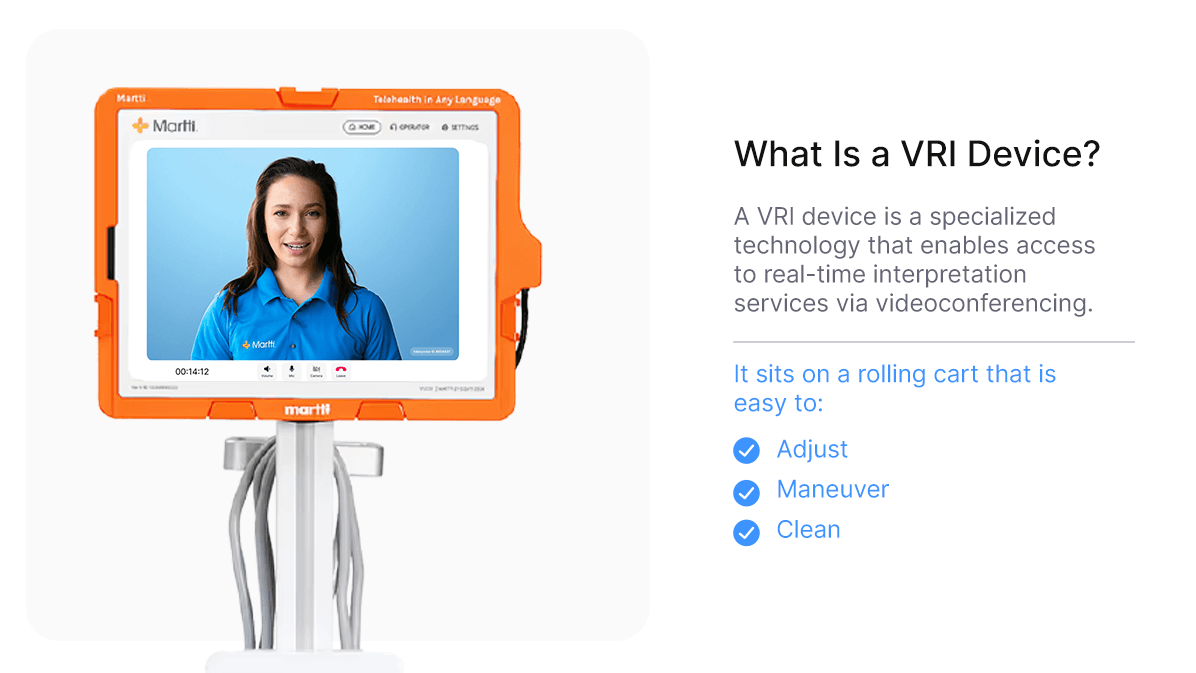
How to Successfully Integrate VRI
Adding VRI to your workflow requires planning and staff training. Consider these steps to ensure a smooth transition:
- Needs assessment: Assess your facility's language needs, identifying which languages are most requested, the volume requested of each, and where there are gaps.
- VRI provider: Partner with a company that meets your specific needs and provides ongoing support as your facility integrates VRI into daily operations.
- Staff training: Train your staff on VRI technology, ensuring everyone knows how to access the service and understands best practices for using it in an effective and timely manner.
- Consistent monitoring: Monitor and improve the process. Gather feedback from staff and patients to refine processes and maximize those VRI benefits.
Challenges and Considerations
To implement VRI successfully, it is crucial to prepare for potential technical challenges that lie ahead. Your facilities need a strong internet connection that supports high-quality audio and video and delivers clear communications. It requires a solid infrastructure, as technical issues can cause delays or disruptions, making it important to have backup communication plans.
Another consideration is patient comfort. Even though the COVID-19 pandemic catalyzed a broader use of video communications, some users may not be familiar with VRI, so introduce the service clearly, address any concerns, and ensure the patient feels heard and understood. Training staff to use VRI effectively improves the experience, reduces frustration, and helps with regulatory compliance and timely access to language services.
Why Trust Us?
Martti is a leader in innovative language access solutions for healthcare providers. We work with healthcare professionals to ensure our language access app is easy to use and highly responsive, seamlessly integrating into a fast-paced environment. Unless you want one, you don't need a special VRI device — just access to an app used on phones, tablets, or computers. Our VRI app works on intuitive navigation and enhanced functionality that includes:
- A native language display with an accessible language selection.
- Dynamic language grids reflecting the most-requested languages.
- An interactive map for quick and easy language selection.
- Built-in interactive guides to improve access to language-accessible care.
- User interface enhancements for more intuitive use.
Partner with Martti for HIPAA-compliant interpreting and interpreters who receive over 120 hours of specialized training. Continuous annual training keeps them up to date on interpreting best practices and medical advancements. Our app integrates with platforms like Cerner, AmWell, Zoom, Epic, and more.
Martti Was the First to Deliver VRI in 2004. Learn More!
As healthcare continues to evolve, technology will play an even greater role in breaking down language barriers. VRI is more than a convenient tool — it's a critical resource for delivering equitable, high-quality care. Integrating VRI into your facility empowers providers to communicate more effectively, improve patient safety, and create a more inclusive environment. If your organization is ready to enhance language access, we're here to help.
At Martti, we have over 20 years of experience in video interpretation. You can request a specific language interpreter, and they will be available in less than 20 seconds on average for the most common languages. Our app supports your compliance with Section 1557 of the Affordable Care Act and the ADA to ensure accessibility for all patients. With updated features and a design that quickly anticipates your needs, investing in the Martti VRI app can significantly improve your operations.
Book a demo today to find out why over 4,000 hospitals, clinics, and health centers love Martti.
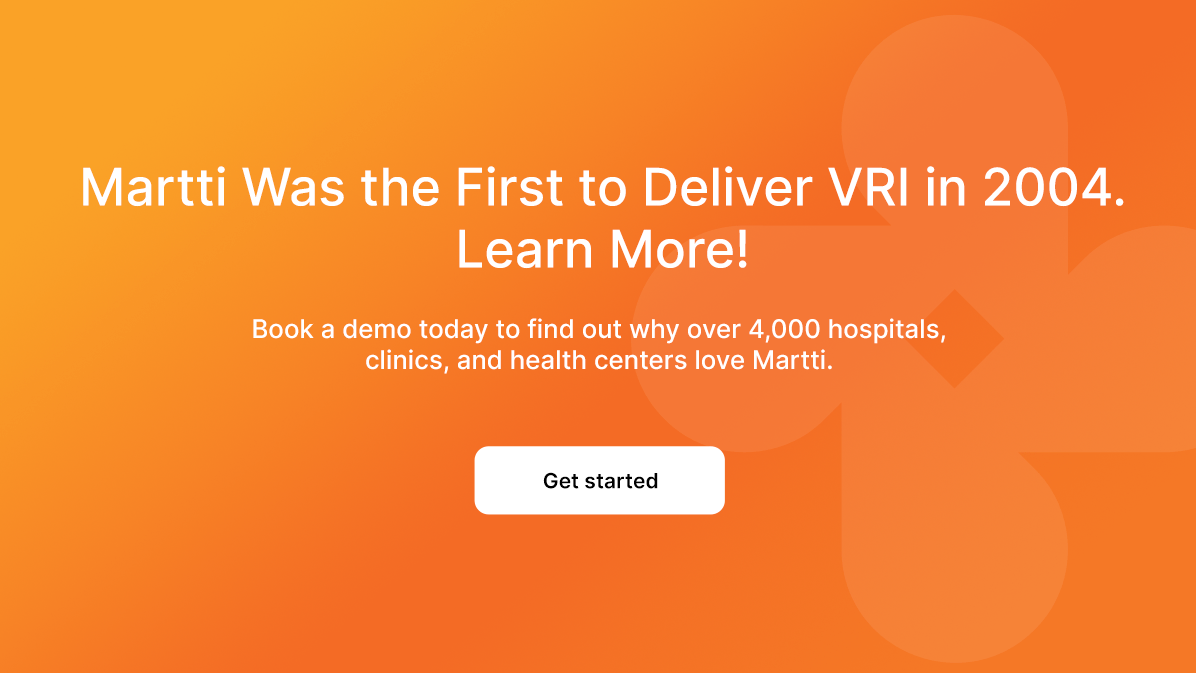
Linked Sources


